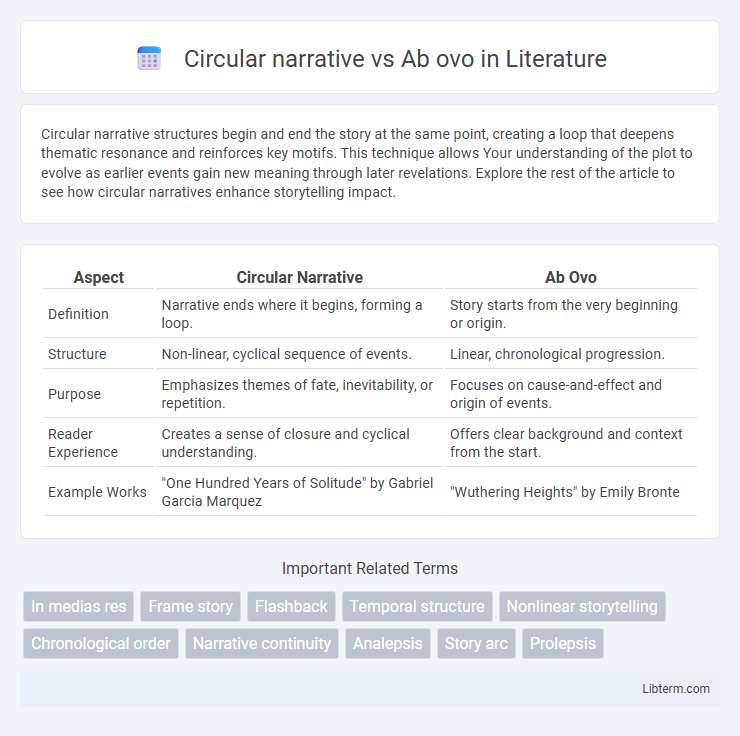Circular narrative structures begin and end the story at the same point, creating a loop that deepens thematic resonance and reinforces key motifs. This technique allows Your understanding of the plot to evolve as earlier events gain new meaning through later revelations. Explore the rest of the article to see how circular narratives enhance storytelling impact.
Table of Comparison
| Aspect | Circular Narrative | Ab Ovo |
|---|---|---|
| Definition | Narrative ends where it begins, forming a loop. | Story starts from the very beginning or origin. |
| Structure | Non-linear, cyclical sequence of events. | Linear, chronological progression. |
| Purpose | Emphasizes themes of fate, inevitability, or repetition. | Focuses on cause-and-effect and origin of events. |
| Reader Experience | Creates a sense of closure and cyclical understanding. | Offers clear background and context from the start. |
| Example Works | "One Hundred Years of Solitude" by Gabriel Garcia Marquez | "Wuthering Heights" by Emily Bronte |
Introduction to Narrative Structures
Circular narrative structures loop back to the beginning, creating a story that ends where it started, emphasizing themes of repetition and inevitability. Ab ovo narratives begin at the chronological start of the story's events, offering a linear and comprehensive introduction to characters and plot. Understanding these two narrative structures is essential for analyzing how stories manipulate time and perspective to affect audience engagement.
Defining Circular Narrative
Circular narrative is a storytelling structure where the story concludes at or near its starting point, creating a loop that emphasizes themes of repetition and inevitability. This contrasts with the ab ovo narrative, which begins from the very origin or chronological beginning of the story's events. Circular narratives often highlight character development through recurring motifs and emphasize the cyclical nature of time or fate.
Explaining Ab Ovo Technique
The ab ovo technique in storytelling refers to starting a narrative from the very beginning, often at the chronological origin of the story or character background, providing audiences with a complete context. This approach contrasts with circular narratives, which may begin in medias res and loop back to the start, creating a cyclical structure. Employing ab ovo offers clear cause-and-effect progression, enriching character development and thematic clarity through a linear timeline.
Key Characteristics of Circular Narratives
Circular narratives are characterized by their repetitive structure, where the story ends at or near its beginning, creating a loop that emphasizes themes of fate and inevitability. This narrative approach often features recurring motifs, symbolic events, and a non-linear timeline that challenges traditional chronological storytelling. In contrast to ab ovo narratives, which start from the origin of the story, circular narratives focus on the cyclical nature of events and the interconnectedness of past and present.
Ab Ovo: Storytelling from the Beginning
Ab ovo storytelling unfolds events in chronological order, beginning from the story's origin to create a clear and linear narrative path. This method allows readers to understand characters' motivations and plot developments from their inception, fostering a natural and immersive experience. Unlike circular narratives, which start in medias res or at the climax and loop back, ab ovo emphasizes a foundational and cause-to-effect progression essential for traditional story comprehension.
Structural Differences: Circular vs. Ab Ovo
Circular narratives revisits the story's starting point, emphasizing cyclical time and thematic closure by looping back to initial scenes or events. Ab ovo structures begin at the very origin of the story's events, providing a linear, chronological progression from cause to effect. The primary structural difference lies in circular narratives' emphasis on repetition and reflection versus ab ovo's straightforward, sequential unfolding of plot.
Impact on Reader Experience
Circular narrative restructures storytelling by ending where it begins, enhancing reader engagement through familiarity and thematic resonance. Ab ovo presents events chronologically from the very beginning, fostering clarity and a straightforward emotional buildup. The impact on reader experience differs as circular narratives provoke deeper reflection, while ab ovo offers a seamless comprehension of character development and plot progression.
Examples of Circular Narratives in Literature
Circular narratives revisit the story's beginning at the end, creating a loop that reinforces key themes and character development. Examples include Joseph Heller's "Catch-22," where events circle back to the protagonist's initial conflicts, and Gabriel Garcia Marquez's "One Hundred Years of Solitude," which mirrors the cyclical nature of history within the Buendia family saga. This structure contrasts with ab ovo narratives that start strictly from the chronological beginning of the story.
Notable Ab Ovo Storytelling Examples
Notable ab ovo storytelling examples include Homer's "The Iliad," which begins chronologically from the events leading to the Trojan War, and Jane Austen's "Pride and Prejudice," starting from the initial introduction of key characters and their social settings. This linear narrative structure provides a clear cause-and-effect progression, making complex plots easier to follow. In contrast, circular narratives revisit starting points and events, creating a cyclical storytelling experience that challenges traditional temporal order.
Choosing the Right Narrative Technique
Choosing the right narrative technique depends on the story's purpose and audience engagement goals. Circular narratives effectively emphasize themes of fate and consequence by returning to the starting point, creating a sense of closure and reflection. Ab ovo structures provide chronological clarity and detailed character development by beginning at the story's origin, ideal for complex plot progression.
Circular narrative Infographic

 libterm.com
libterm.com